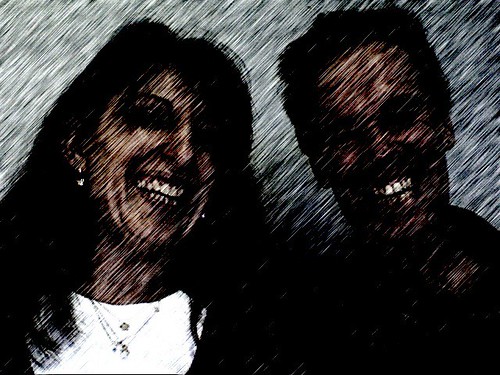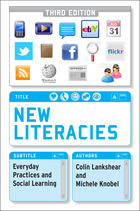Thursday, June 24, 2004
Wearables...
Here's the latest on wearable information and communication devices via Octeto. Mobile connectivity as jewellery I get, but I'm still not sure about the wash-n-wearability of phones wired into clothing etc.
And this recent development puts a whole new spin on the concept of "wearable"--fancy a patch of skin that also acts as a keyboard, anyone?
i-home
A 2003 article by Jane Pinckard and Justin Hall in The Feature reminds us that the "old" technology of personal homepages may well be undergoing interesting transformatrions as personal webpages, blogs and i-mode converge to create "i-home" websites. These websites can be read and updated via i-mode equipped mobile phones. Pinckard and Hall argue convincingly that,
"Historically new mobile technologies have been marketed to businesses, but i-mode homepages prove that people want to create and not just consume mobile culture."
The i-home pages created by users tend to be mroe diary or blog-like than traditional personal websites, but are nonetheless maintain the idiosyncracies often found on personal homepages during the hey-day of the online homestead rush (e.g., "my website about my guinea pigs", "Steve and Tania's Wedding").
New research on mobile telephony and youth in the Asia-Pacific region
Recent research reported by the Taylor Nelson Sofres Asia Telecoms Index suggests that mobile phone ownership among 13 to 15 year olds in the Asia-Paciofic region is rapidly increasing. The Index surveyed 12 Asia-Pacific nations, including Australia, Singapore and Hong Kong, among others (not listed). I came across reference to the report in The Australian online, and am still trying to track down the orginal report. oddly enough, The Australian report claims that Australian youth aged 13 to 15 years "lead the world in mobile telephone use" with the caveat that this holds everywhere except for in Hong Kong (which hardly makes Australian youth the "leaders" then!); moreover, it's not clear whether Japan was included in the survey. Japanese youth have long been the most mobile communicators in the world. Norway and Sweden certainly weren't, and yet both countries have exceptionally high teenage mobile phone ownership rates.
Nonetheless, the survey does point to interesting trends in terms of mobile phone ownership and preferences(e.g., Australian youth were found to prefer mobile internet and other multimedia functions over cheaper services).
Wednesday, June 23, 2004
Viruphone worm on the loose...
Bradley Mitchell reports on the first worm written expressly for mobile phones. The worm, known as "Cabir", "spreads through a phone's Bluetooth wireless networking interface" and although it doesn't seem to cause damage, it has fascinating implications for the next generation of digital viruses.
On a similar note, a grad student of ours recently reported receiving a spam email message on her mobile phone....
Time to Read
A few posts back we threatened to write about our experience doing a keynote talk at the 20th anniversary conference of Time Warner's Time to Read literacy program. The time has arrived.
"Time to Read" is the largest corporate-sponsored volunteer literacy initiative in the US. The program matches targets struggling readers with volunteer reading mentors. It targets readers in three age groups – children in grades 3 to 6, teens in grades 7 to 12, and adults – using Time Inc. magazines, videos and other reference materials. Many Time Warner employees act as tutors. In addition, 10 campus literacy programs currently offer adult, ESOL and child literacy programs in their communities, supported by the Student Coalition for Action in Literacy Education .
Our friend and colleague, Don Leu, had suggested us as possible keynote speakers, and we duly received an invitation from the Time to Read co-ordinator, Allison Burns-Ferro. Our job was to say something about some of the new electronic literacies that teens are especially engaged in. We were sharing a session slot with Jacquie Moen, CEO for AOL's kids' service.
While we only had to speak for 30 minutes or so (although we went a bit longer), we were more challenged by this assignment and more nervous in approaching it than any other talk we have ever done. Had we known that we would be talking after Mawi Asgedom, recently interviewed by Oprah and named by Essence magazine as one of its 40 most inspiring African Americans, we might have thought twice about taking the task on.
We spoke about instant messaging, with particular reference to the kinds of 'disorders' that literacy prudes identify as being caused by coming into contact with IM. These are things like bad spelling and grammar, inability to write long sentences and to generate complex and sustained thoughts, and so on. We did our best to redress a balance.
The sessions we attended were very interesting, and we came away with a fresh perspective on corporate initiatives of this kind, and are keen to follow up the possibility of closer contacts with the program.
Tuesday, June 22, 2004
New Literacies
The last week has mainly been taken up with driving Midnight, our '89 Mustang, from New Jersey to Vera Cruz, Mexico. Midnight has her papers to join us as Mexican residents, and it will be great to have her here.

Map reading, road sign following, and watching out for Waffle House diners and billboards for friendly motels have been our everyday literacies for the past week. Oldies, but goodies.
Just before we left New Jersey, though, we got copies of the most recent book to be published in our "New Literacies" series with Peter Lang. This is Juha Suoranta and Hanna Lehtimaki's book Children in the Information Society, which focuses on Finland as a case study. It is an excellent read.
Other books already published in the series are:
Joanne Larson (ed) Literacy as Snake Oil: Beyond the Quick Fix
Jabari Mahari (ed) What They Don't Learn in School
Carey Jewitt and Gunther Kress (eds) Multimodal Literacy
Donna Alvermann (ed) Adolescents and Literacies in a Digital World
Michael Singh, Peter Kell and Ambigapathy Pandian (eds) Appropriating English: Innovation in the Global Business of English Language teaching
Amy Scholder and Eric Zimmerman (eds) Re:Play: Game Design + Game Culture
Several more books are imminent in this series, and we will let you know when they appear.
Tuesday, June 15, 2004
Last Post for Johnny Ramone
A sad day. Yahoo has just posted rollingstone.com's announcement that Johnny Ramone is losing his battle with prostate cancer. First Joey, then Dee Dee. And sometime in between the two of them going, and on the other side of the ocean, the conscience of us all, Joe Strummer, broke his heart for the last time. Majorly literate people of a precious moment, leaving us all too soon. The very best of everyday literacies.
"It's not hard
not hard to reach,
we can hitch a ride
to Rockaway Beach"
NOT fair.
With much love and happy memories, Johnny. You keep fighting, fella, and we'll keep you in our hearts and minds. And one of these days we'll all catch up in Punk Heaven.
Sunday, June 13, 2004
Big Day (and Night) Out
The "Time to Read" Gig and Airport Extreme
On Friday (11th) we had the privilege of presenting some of our ideas about Instant Messaging to the biennial seminar provided by the Time-Warner-AOL Corporation for participants in it Time to Read program. Our colleague, Don Leu, had kindly suggsted us as presenters, and we accepted the invitation.
We knew little about the program before, but quickly got on to the task of getting up to speed. It would be an understatement if we said we had been nervous in the lead up to the event. Much of our uncertainty was based on not having a clear sense of who the audience would be. Talking with Don Leu helped a lot, as did teleconferencing with Allison Burns-Ferro,who runs the Time to Read program, and Jacquie Moen (from AOL) who was doing the first part of the session with us.
Happily for us the talk went well and the feedback was very heartening. But the real thrill was getting to see the nature and scope of the program up close, and to get a good inside sense of its various dimensions as seen through the eyes of key people involved. Because the program is interesting, and because we hope to maintain links with it, we will make some further posts on this theme in the days and weeks ahead.
We also want to write our talk up into a formal paper and publish it online and in print. (Watch this space.)
However, the thing we want to talk about right now is our luck the evening before the talk. We took the train from the Montclair Heights (Montclair State University) stop to Penn Station (NYC) on Thursday afternoon. We planned to register and then locate the nearest Apple Store to go buy an Airport Base Station to set up a wireless network for our computers at home and at work. We located the nearest Apple Store down in Soho and caught the R train from mid town, where we were staying.
Finding the store at 103 Prince Street was easy. We checked out the visible information on the Airport Extremes, got one and took it to the counter to pay, and to ask about an antenna. We had read the information as saying that the Extreme cost $199 (US) and that the $249 model included the antenna. 'No', said the man. 'The antenna is separate. There is a $199 model and a $249 model, and the antenna costs a further $99 on top of whichever one you buy'. We asked what was the difference. The guy explained that the more expensive model had a port for dial in as well as LAN and WAN Ethernet.
Pardon our ignorance, but we had had no idea previously that a dial in connection could possibly support wireless. Even though we expected the links to be slow using dial in we could not resist the option. We bought the $249 model.
Good choice! For sure the ethernet connection at work on a good day is much faster (and even without the antenna the range is good) than the dial in at home. But the latter is suprisingly good. It seems to us to be somewhat faster with 3 machines running on wireless than with a single machine connected by modem direct to the phone line. Let's just say that when we buy another one to take back to Mexico and for use in Australia, we won't be in a hurry to get cable. The dial in connection will suffice perfectly well for the time being.
And the special bonus was finding that Apple has Airport management software for PCs running Win 2000 and XP. So you can use the Airport extreme with your PC. Along with the ever loving iPod, and my firewire card (that makes a 1999 IBM Thinkpad running XP on maximum RAM sufficient for my daily needs even now in 2004), this is our happiest tech purchase in a while.
READ600
Assignments
Just a note to any students checking this space (grin) that your assignments will be available from Monday afternoon (14th). They will be in Michele's office. The work was uniformly good. I am delighted with the results and want to thank all of you for taking part in the course. Also, of course, I want to thank Michele for making it possible to cover all the ground we did, for organizing the Lab times, and fo taking the roll!!
This was the first time I had had the opportunity to make use of wireless internet access in formal teaching and learning work. I found it incredibly useful and will continue to think of how to make stil better use of the facility.








